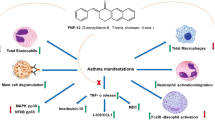Abstract
Eosinophils have been recognized to be associated with various immune responses and disease processes including bronchial asthma. Eosinophils release a number of cytotoxic and neurotoxic mediators. However, the factors regulating such release and the underlying mechanisms are unclear. In this study, we investigated the effect of a selective and potent thromboxane synthase inhibitor, DP-1904, on the release of eosinophil cationic protein (ECP) in platelet activating factor (PAF) and IgG-stimulated human blood eosinophils. PAF (1 μM) and IgG both released ECP which constituted about 25–30% of the total ECP content. The control protein, ovalbumin, did not release any ECP over the basal values. DP-1904 in two different concentrations, 10 μM and 100 μM, significantly attenuated the release of ECP in response to PAF or IgG. The mean percent inhibition by 10 μM DP-1904 was 49 ± 10 and 31 ± 2 against PAF and IgG-induced ECP release, respectively. However, at 100 μM DP-1904 the percent inhibition was 76 ± 14 and 67 ± 2, respectively. These data suggest that TXA2 is an important mediator in the regulation of eosinophil degranulation, and DP-1904 thus might prove beneficial in the treatment of bronchial asthma.
Similar content being viewed by others
REFERENCES
KAY, A. B. 1989. Inflammatory cells in bronchial asthma. J. Asthma. 23:335–344.
DURHAM, S. R., and A. B. KAY. 1985. Eosinophils, bronchial hyperreactivity, and late-phase asthmatic reactions. Clin. Allergy 15:411–416.
FRIGAS, E., and G. J. GLEICH. 1986. The eosinophil and the pathophysiology of asthma. J. Allergy Clin. Immunol. 77:527–533.
WELLER, P. F. 1991. The immunobiology of eosinophils. N. Engl. J. Med. 324:1110–1115.
TAYLOR, K. J. and A. R. LUKSZA. 1987. Peripheral blood eosinophil counts and bronchial responsiveness. Thorax 42:452–460.
TAMURA, N., D. K. AGRAWAL, and R. G. TOWNLEY. 1988. Leukotriene C4 production from human eosinophils in vitro: Role of eosinophil chemotactic factors on eosinophil activation. J. Immunol. 141:4291–4297.
TAYLOR, I. K., P. L. WARDS, K. M. O'SHAUGHNESSY, C. I. DOLLERY, P. BLACK, S. E. BARROW, G. W. TAYLOR, and R. W. FULLER. 1991. TXA2 biosynthesis in acute asthma and after antigen challenge. Am. Rev. Respir. Dis. 143:119–125.
KANAO, M., Y. WATANABE, Y. KIMURA, J. SAGUSA, K. YAMAMOTO, H. KANNO, N. KANAYA, H. KUBO, S. ASHIDA, and F. ISHIKAWA. 1989. Thromboxane A2 synthetase inhibitor. Syntheses and activities of Tetrahydronaphthalene and Indan derivatives. J. Med. Chem. 32:1326–1334.
TAKAMI, M., Y. TAKATA, K. MATSUMOTO, S. ONO, and W. TSUKADA. 1991. Effect of DP-1904, a new thromboxane A2 synthetase inhibitor, on guinea pig experimental asthma. Ann. N.Y. Acad. of Sci. 629:407–409.
AGRAWAL, D. K., M. TAKAMI, and S. ONO. 1993. DP-1904: a novel thromboxane A2 (TXA2) synthetase inhibitor attenuates the effect of inflammatory mediators in human monocytes and lymphocytes. Am. Rev. Respir. Dis. 147:A448.
TAKAMI, M., K. MATSUMOTO, Y. TAKATA, K. FURUHAMA, and W. TSUKADA. 1995. Possible role of thromboxane A2 in hyperresponsiveness of isolated rat lung tissue in a Sephadex-induced eosinophilia model. Int. Arch. Allergy Immunol. 106:401–409.
NUMAO, T. and D. K. AGRAWAL. 1992. Neuropeptides modulate human eosinophil chemotaxis. J. Immunol. 149:3309–3315.
MANNING, P. J., W. H. STEVENS, D. W. COCKCROFT, and P. M. O'BYRNE. 1991. The role of thromboxane in allergen-induced asthmatic responses. Eur. Respir. J. 4:667–673.
IWAMOTO, I., C. RA, T. SATO, H. TOMIOKA, and S. YOSHIDA. 1988. Thromboxane A2 production in allergen-induced immediate and late asthmatic responses. Its possible role in inducing the late response. J. Asthma 25: 117–124.
SLADEK, K., R. DWORSKI, G. A. FITZGERALD. 1990. Allergen-stimulated release of thromboxane A2 and leukotriene E4 in humans. Effect of indomethacin. Am. Rev. Respir. Dis. 141:1441–1445.
LUPINETTI, M. D., J. R. SHELLER, F. CATELLA, and G. A. FITZGERALD. 1989. Thromboxane biosynthesis in allergen-induced bronchospasm. Evidence for platelet activation. Am. Rev. Respir. Dis. 140:932–935.
KUMLIN, M., B. DAHLEN T. BJOERCK, O. ZETTERSTROEM, E. GRANSTROEM, and S. E. DAHLEN. 1992. Urinary excretion of LTE4 and 11-dehydro TXB2 in response to bronchial provocations with allergen, aspirin, LTD4, and histamine in asthmatics. Am. Rev. Respir. Dis. 146:96–103.
BUTCHERS, P. R. and C. J. VARDEY. 1990. The effect of prostanoids on the function of human eosinophils. Agents and Actions suppl.31:103–l12.
PARSONS, W. G., and L. J. ROBERTS. 1988. Transformation of prostaglandin D2 to isomeric prostaglandin F2 compounds by human eosinophils: a potent mast cell-eosinophil interaction. J. Immunol. 141:2413–2419.
FOEGH, M. L., Y. T. MADDOX, and P. W. RAMWELL. 1986. Human peritoneal eosinophils and formation of arachidonate cyclooxygenase products. Scand. J. Immunol. 23:599–603.
WHITE, S. R., M. E. STREK, G. V. P. KULP, S. M. SPAETHE, R. A. BURCH, S. P. NEELEY, and A. R. LEFF. 1993. Regulation of human eosinophil degranulation and activation by endogenous phospholipase A2. J. Clin. Invest. 91:2118–2125.
DVORAK, A. M., P. F. WELLER, V. S. HARVEY, E. S. MORGAN, and H. F. DVORAK. 1993. Ultrastructural localization of prostaglandin endoperoxide synthase (cyclooxygenase) to isolated, purified fractions of guinea pig peritoneal macrophage and line 10 hepatocarcinoma cell lipid bodies. Int. Arch. Allergy Immunol. 101:136–142.
DWORSKI, R., G. A. FITZGERALD, and J. R. SHELLER. 1992. Thromboxane synthetase inhibitor in allergen challenged sheep lung: effect on eicosanoid synthesis. Eicosanoids 5:35–37.
TROCHTENBERG, D. S., P. L. LEFFERTS, G. A. KING, Y. S. HWANG, B. W. CHRISTMAN, and J. R. SNAPPER. 1992. Effect of thromboxane synthetase and cyclooxygenase inhibition on PAF-induced changes in lung function and arachidonic acid metabolism. Prostaglundins 44:555–577.
AGRAWAL, D. K. and T. NUMAO. 1993. Transmembrane signaling in cosinophils. In Eosinophils, S. Makino and T. Fukuda, editors. CRC Press, Boca Raton, Florida, pp. 171–192.
SPRY, C. J. F. 1988. In Eosinophils: a comprehensive review and guide to the scientific and medical literature, Oxford Univ Press, Oxford, UK, 1988, pp. 43–80.
NUESSE O., M. LINDAU, O. CROMWELL, A. B. KAY, and B. D. GOMPERTS. 1990. Intracellular application of guanosine-5′-O-(3-thiotriphosphate) induces exocytotic granule fusion in guinea pig eosinophils. J. Exp. Med 171:775–781.
Author information
Authors and Affiliations
Rights and permissions
About this article
Cite this article
Agrawal, D.K., Takami, M. & Ono, SE. A Novel Thromboxane Synthetase Inhibitor, Dp-1904, Inhibits Human Blood Eosinophil Degranulation. Inflammation 21, 1–8 (1997). https://doi.org/10.1023/A:1027330506697
Issue Date:
DOI: https://doi.org/10.1023/A:1027330506697




